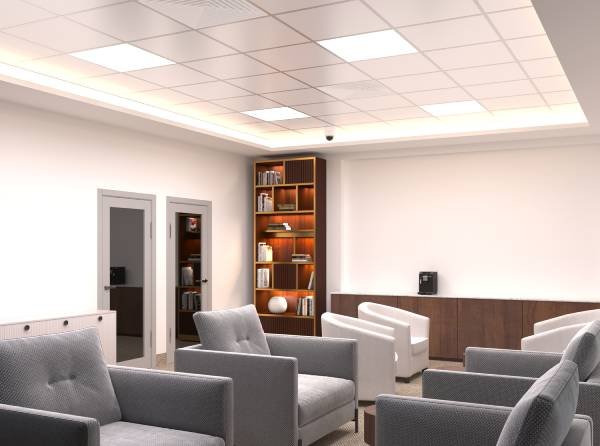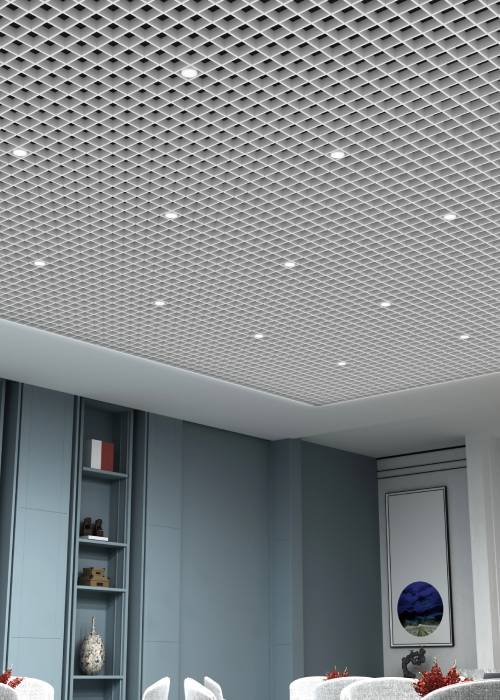Acoustic boards help lessen undesirable reflected sound in any room...
False ceilings have practical characteristics in addition to aesthetics that make them more useful in more ways than one. False ceilings, for example, have superb acoustics, allowing needed sounds to be amplified while undesirable noises are reduced. Electric lines, pipes, and air-conditioning ducts are all housed in them. False ceilings may reflect and disperse light, reducing the need for artificial lighting and therefore cutting energy usage. These ceiling panels also have fire resistance and moisture resistance.
As a result, a well-designed fake ceiling delivers both practical and aesthetic benefits that may significantly improve the working environment.
False ceilings come in a variety of shapes and sizes, depending on their intended use. These ceiling tiles come in a variety of materials and provide a variety of characteristics. False ceiling panels are commonly utilised and may be customised to create elaborate designs that complement the ceiling’s aesthetics.


Plaster of Paris (POP) is one of the most widely utilised roofing materials in both commercial and residential applications. POP is a powdered form of gypsum that has been stripped of its water content (produced by heating gypsum to a temperature where water evaporates). When water is added, it hardens and becomes a good ceiling material. POP is low-maintenance and long-lasting, as well as effective cold and heat insulators. POP fake ceilings may be designed in a variety of ways and can have a variety of finishes, including a uniform and smooth surface as well as a variety of forms. It’s also a great material for boosting lighting effects. The main disadvantage of POP is its proclivity for cracking over time.
Gypsum is a calcium sulphate that is found as an evaporite mineral. Because of its thermal and acoustic insulation, lightweight, and fire resistant characteristics, it is a popular material for fake ceilings. It’s also a supple fabric. To create a fake ceiling, square gypsum boards can be suspended on an iron structure. Gypsum comes in a variety of colours, including brown, white, red, yellow, and grey. It’s also available in transparent and colourless versions. Finishing gypsum boards with laminates and paints can improve their visual appeal. Wallpaper and texture treatments can be applied to gypsum boards. Gypsum is a versatile material that may be moulded into a variety of shapes and textures, including plain, curved, stepped, and coffered.
The sound and heat insulation qualities of fibre fake ceilings, also known as acoustic or soundproofing ceilings, are achieved by combining natural and synthetic materials such as bitumen, tars, vegetable fibre, wood, and stone. Fibre ceiling tiles gain durability, hardness, and fire resistance as a result of the reinforcements, making them ideal for commercial applications in loud environments such as shopping malls, retail showrooms, and offices.
Fibre fake ceilings are gaining popularity in commercial applications due to its low cost, ease of installation, and several practical advantages. Fibre ceiling panels, on the other hand, are not suited for residential usage due to their lack of visual appeal.
Natural patterns and textures on wooden fake ceilings can be pleasing to the eye. Working with wood is an excellent idea. Hollow blocks, boards, and panels are all examples of wooden panels. They’re usually simple to put together, requiring only screws and nails. They are best used in colder climates. They are long-lasting, although they are prone to termite damage and warping. They can be completed in a variety of ways, including painting with the right colour hues.
Because of the high cost of materials and the greater cost of upkeep, wood panels are among the most costly panels. Wood ceiling panels, on the other hand, may provide a rich and elegant appeal to the ceiling if money isn’t an issue.
Glass is a good material to work with for improving the appearance of a fake ceiling since it is non-crystalline but transparent. It has limited applications because to its brittle nature, although the brittleness may be decreased by adding appropriate additives. Their transparency may be utilised to make small areas appear larger. In places like libraries, cafés, book stores, and jewellery stores, glass ceiling panels might be a good roofing option. Color, lamination, and patterning are all design aspects that may be used to glass. Glass is also a strong heat insulator.
False ceilings are commonly made of metals like aluminium and galvanised iron. By their very nature, metals are tough and long-lasting. These ceiling panels are simple to instal and need little upkeep. They may also be readily removed and replaced, making them perfect for concealing water pipes, air ducts, and electric cables. Metal ceiling panels can be treated in a variety of ways to improve the ceiling’s visual appeal.
False ceilings made of fabric or synthetic leather are more decorative than practical. Because they may be made in a variety of complex designs to complement the rest of the decor, they can create a unique atmosphere. They are helpful in transitory settings such as exhibits or festivals since they are functionally poor but visually strong.
False ceilings are usually drop ceilings, meaning they dangle from the main ceiling. Drop ceiling panels, as mentioned above, are used to create ceilings that are visible to individuals within a structure or room. A stretch ceiling is a drop ceiling variant in which specific types of materials are stretched between two perimeter rails. Ceilings may be made to come alive with a little ingenuity and invention, given the variety of materials that can be utilised as ceiling panels.
Acoustic boards help lessen undesirable reflected sound in any room...
Acoustic boards help lessen undesirable reflected sound in any room...
Open spaces have been known as the trending layout for...
WhatsApp us